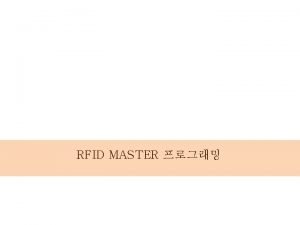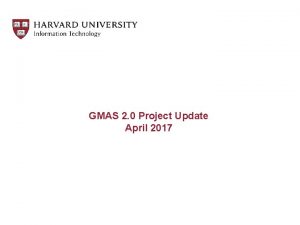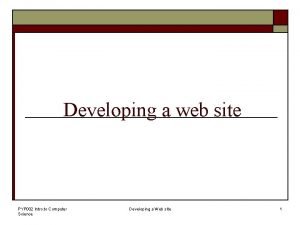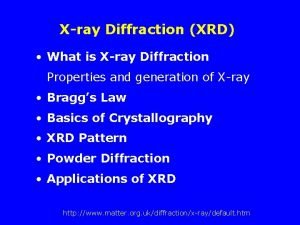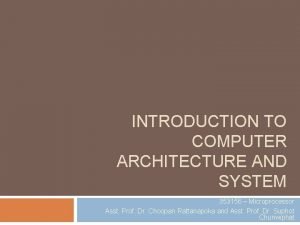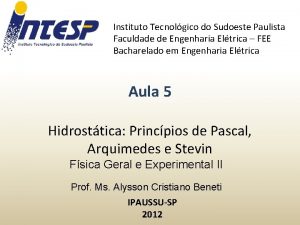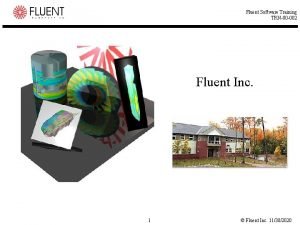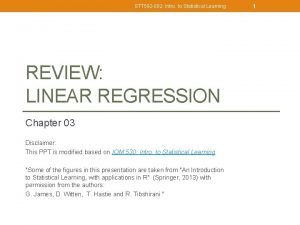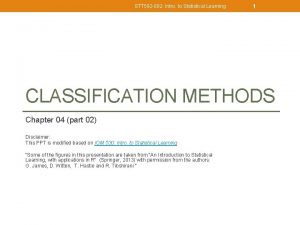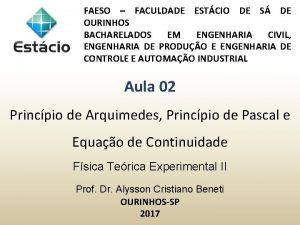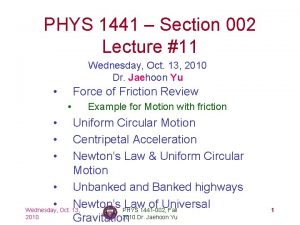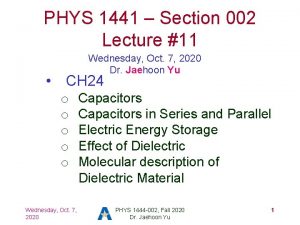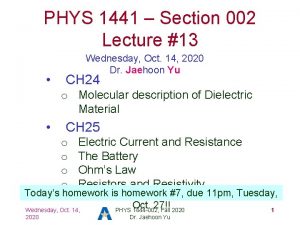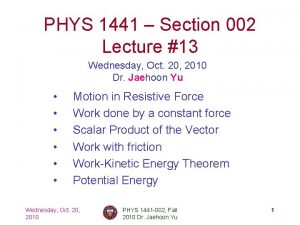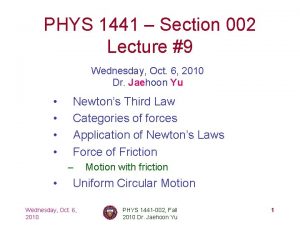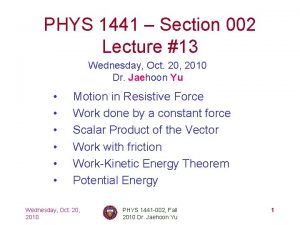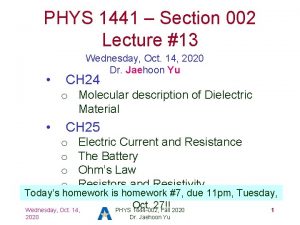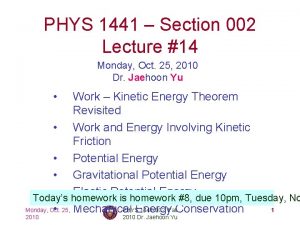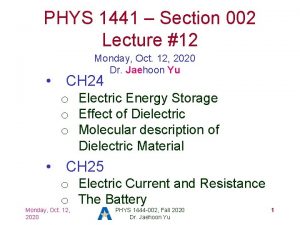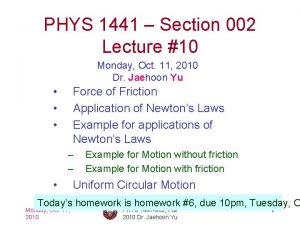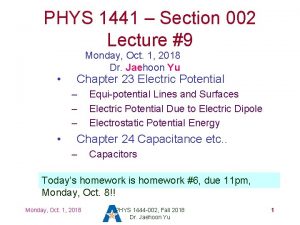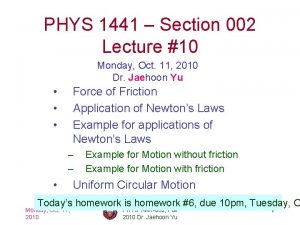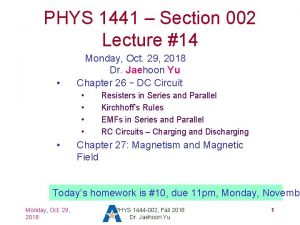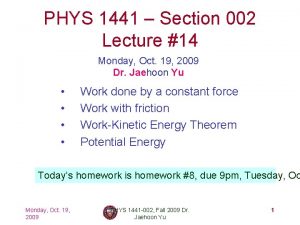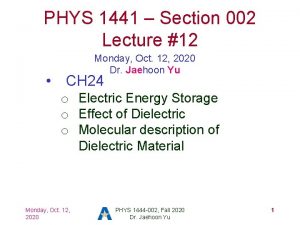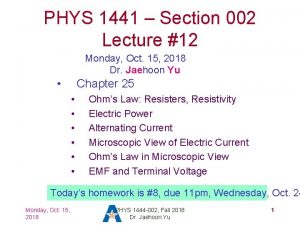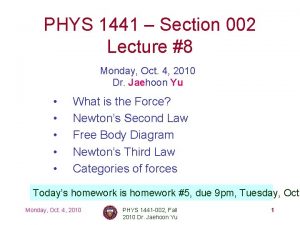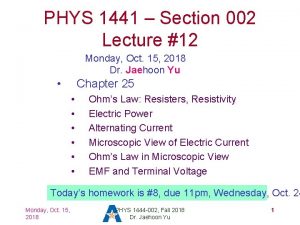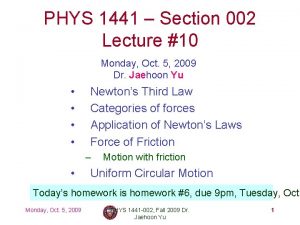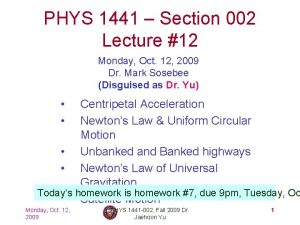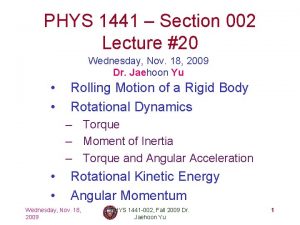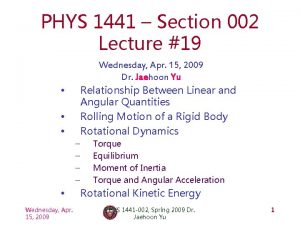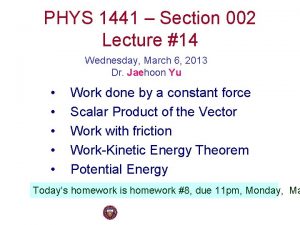PHYS 1441 Section 002 Lecture 13 Wednesday Oct
























- Slides: 24

PHYS 1441 – Section 002 Lecture #13 • Wednesday, Oct. 14, 2020 Dr. Jaehoon Yu CH 24 o Molecular description of Dielectric Material • CH 25 o o Electric Current and Resistance The Battery Ohm’s Law Resistors and Resistivity Today’s homework is homework #7, due 11 pm, Tuesday, Oct. 27!! Wednesday, Oct. 14, PHYS 1444 -002, Fall 2020 1 2020 Dr. Jaehoon Yu

Announcements • Reading assignments: CH 25. 8 – 10 • Online Mid-term comprehensive exam on Quest; roll call at 12: 50 – In class Monday, Oct. 19; You will get an F if you miss the exam! – Covers: CH 21. 1 through what we finish today, Oct. 14 (CH 25. 4? ) + math refresher – BYOF: You may bring a one 8. 5 x 11. 5 sheet (front and back) of handwritten formulae and values of constants for the exam – No derivations, word definitions, setups or solutions of any problems, figures, pictures, diagrams or arrows, etc! – No additional formulae or values of constants will be provided! – Must send me the photos of front and back of the formula sheet, including the blank, no later than 11 am the day of the exam • Once submitted, you cannot change, unless I ask you to delete some part of the sheet! • Special seminar on COVID – 19: 3: 30 pm Sunday, Oct. 25 Wednesday, Oct. 14, PHYS 1444 -002, Fall 2020 2 2020 – Dr. Linda Lee Dr. Jaehoon Yu

• SP#5 – Civic Duty II: Election Participation Election on Nov. 3 with early voting Tue. Oct. 13 – Fri. Oct. 30 • For those with legal voting rights: You can submit three access code green sheet for 20 points total – one your own and two others who voted, 5 points each. Any additional ones will earn 2 points each • For those without legal voting rights: You can submit for the first four access code green sheets for 20 points total, 5 points each and any additional combinations 2 points each. • Be sure to tape one side of the stickers on a sheet of paper with your name on it. – Write the full name of the person next to the corresponding access code sheet • None of the stickers can be from the same person on Wednesday, Oct. 14, PHYS 1444 -002, Fall 2020 3 someone else’s extra credit or. Yuon your own. All of those 2020 Dr. Jaehoon

Access code sheet Wednesday, Oct. 14, 2020 PHYS 1444 -002, Fall 2020 Dr. Jaehoon Yu 4

SP #6 – Statistical Analysis : COVID 19 • Make comparisons of COVID-19 statistics between the U. S. , South Korea, Italy and Texas from https: //coronaboard. com on spreadsheet – Total 44 points: 1 point for each of the top 20 cells and 2 points for each of the 12 cells for testing • • Fill the US Historic event analysis table at the bottom half of the sheet (2 points per cell, 24 points total) and make a >3 sentence statement on COVID 19 with respect to other events (6 points) What are the 3 fundamental quantitative requirements for opening up (2 points each, 6 points total)? – Must be quantitative! (e. g. number of tests per capita per day, positivity rate, etc) • • Assess the readiness of the three fundamental requirements U. S. (Do NOT just take politician’s words!). Must provide the independent scientific entity’s reference you took the information from. (2 point each, total 6 points) Evaluate quantitatively the success/failure of the US responses to COVID-19 in 5 sentences. Must provide quantitative reasons behind your conclusion! (2 points each sentence, 10 points total) Assess quantitatively the effectiveness of wearing masks (4 points) and at least 4 reasons for it being effective (1 point each, 0. 5 point extra after the first 4). Due: 11 pm, Friday, Oct. 23 –Wednesday, Submit one including the spreadsheet Oct. pdf 14, file SP 6 -Your. Last. Name-Your. First. Name. pdf, PHYS 1444 -002, Fall 2020 5 Jaehoon. Download Yu – 2020 Spreadsheet has been posted on. Dr. canvas. ASAP.

SP 6 spreadsheet Wednesday, Oct. 14, 2020 PHYS 1444 -002, Fall 2020 Dr. Jaehoon Yu 6

Molecular Description of Dielectric • So what in the world makes dielectrics behave the way they do? • We need to examine this in a microscopic scale. • Let’s consider a parallel plate capacitor that is charged up +Q(=C 0 V 0) and –Q with air in between. – Let’s assume there is no way any charge can flow in or out • Now insert a dielectric – Dielectric can be polar could have permanent dipole moment. What will happen? Wednesday, Oct. 14, 2020 • Due to the electric field molecules will be PHYS 1444 -002, Fall 2020 7 aligned. Dr. Jaehoon Yu

Molecular Description of Dielectric • OK. Then what happens? • Then effectively, there will be some negative charges close to the surface of the positive plate and positive charge on the negative plate – Some electric field do not pass through the whole dielectric but stops at the negative charge – So the field inside dielectric is smaller than in air • Since the electric field is smaller, the force is smaller Wednesday, Oct. 14, 2020 – The work need to move a test charge inside the dielectric is smaller – Thus the potential difference across the PHYS 1444 -002, Fall 2020 than across the air 8 dielectric is smaller Dr. Jaehoon Yu

Electric Current and Resistance • So far, we have been studying static electricity – What is the static electricity? • The charges so far has not been moving but staying put at the location they are placed. • Now we will learn dynamics of electricity • What is the electric current? – A flow of electric charge – What are a few examples of the things that use electric current in everyday lives? • In an electrostatic situation, there is no electric field inside a conductor but when there is current, there is field inside a conductor. Why? – Electric field is needed to keep charges moving Wednesday, Oct. 14, 2020 PHYS 1444 -002, Fall 2020 Dr. Jaehoon Yu 9

The Electric Battery • What is a battery? – A device that produces electrical energy from the stored chemical energy and produces electricity Maintains potential difference! • Electric battery was invented by Volta in late 1790 s in Italy – It was made of disks of zinc and silver w/ salt-water soaked clothes based on his research that certain combinations of materials produce a greater electromotive force (emf), or potential, than others – Pile (or a battery) of these connected to make up the first battery! • Simplest batteries contain two plates made of dissimilar metals called electrodes Wednesday, Oct. 14, PHYS 1444 -002, Fall 2020 10 Dr. Jaehoon – Electrodes are immersed in a. Yusolution, the electrolyte 2020

How does a battery work – I? • One of the electrodes in the figure is zinc and the other carbon • The acid electrolyte reacts with the zinc electrode and dissolves it. • Each zinc atom leaves two electrons in the electrode and enters into the solution as a positive ion zinc electrode acquires negative charge and the electrolyte (the solution) becomes positively charged • The carbon electrode picks up the positive charge • Since the two terminals are oppositely charged, there Oct. is 14, a potential Wednesday, PHYSdifference 1444 -002, Fall 2020 between them 11 2020 Dr. Jaehoon Yu

How does a battery work – II? • When the terminals are not connected, only the necessary amount of zinc is dissolved into the solution. • How is the particular potential difference maintained? – If the terminals are not connected, as too many zinc ions get produced, • zinc electrode gets increasingly charged up negative • zinc ions get recombined with the electrons in zinc electrode • Why does battery go dead? – When the terminals are connected to a circuit, the negative charges will flow away from the zinc electrode – More zinc atoms dissolve into the electrolyte to produce more. Oct. charge Wednesday, 14, PHYS 1444 -002, Fall 2020 12 2020 Dr. Jaehoon Yu

Electric Current • When a circuit is powered by a battery (or a source of emf) the charge can flow through the circuit. • Electric Current: Any flow of charge – Current can flow whenever there is a potential difference between the ends of a conductor (or when the two ends have opposite charges) • The current can flow even through the empty space under certain conditions – Electric current in a wire can be defined as the net amount of charge that passes through the wire’s full Unit (Poll 3)? cross section at any point per unit time (just like the flow of water through a conduit. ) C/s 1 A=1 C/s – Average current is defined as: Scalar – The instantaneous current is: In a single circuit, conservation of Fall electric charge guarantees 13 Oct. 14, of a quantity PHYS 1444 -002, 2020 –Wednesday, What kind is the current? (poll 2) that 2020 the current at one point the Yu circuit is the same as any Dr. of Jaehoon

Example 25 – 1 Current is a flow of charge: A steady current of 2. 5 A flows in a wire for 4. 0 min. (a) How much charge passed by any point in the circuit? (b) How many electrons would this be? Current is total amount charge flown through a circuit in a given time. So from we obtain The total number of electrons passed through the circuit is Wednesday, Oct. 14, 2020 PHYS 1444 -002, Fall 2020 Dr. Jaehoon Yu 14

Direction of the Electric Current • What do conductors have in abundance? – Free electrons • What happens if a continuous loop of conducting wire is connected to the terminals of a battery? – Electrons start flowing through the wire continuously as soon as both the terminals are connected to the wire. Why? • The potential difference between the battery terminals sets up an electric field inside the wire and in the direction parallel to it (poll 11) • Free electrons in the conducting wire get attracted to the positive terminal • The electrons leaving negative terminal flow through the wire and arrive at the positive terminal – Electrons flow from negative to positive terminal Wednesday, Oct. 14, PHYS 1444 -002, Fall 2020 15 – 2020 Due to historical convention, Dr. Jaehoonthe Yu direction of the current

• Ohm’s Law: Resistance and Resistors What do we need to produce electric current? – Potential difference • George S. Ohm experimentally established that the current is proportional to the potential difference ( ) – If we connect a wire to a 12 V battery, the current flowing through the wire is twice that of 6 V, three times that of 4 V and four times that of a 3 V battery – What happens if we reverse the sign of the voltage? • It changes the direction of the current flow • Does not change the magnitude of the current – Just as in water flow case, if the height difference is large the flow rate is large If the potential difference is Wednesday, Oct. 14, PHYS 1444 -002, Fall 2020 16 large, the current is large. 2020 Dr. Jaehoon Yu

Ohm’s Law: Resistance • The exact amount of current flow (I) in a wire depends on – The voltage (V) – The resistance of the wire (R) to the flow of electrons • Just as the gunk in water pipe slows down water flow • Electrons are slowed down due to interactions with the atoms in the wire • The higher the resistance (R) the less the current Unit (poll 3 (I) for the given potential difference V – So how would you define resistance? Ohm’s Law ohms • Such that current is inversely proportional to the resistance – Often it is rewritten as – What does this mean? • The metal conductor’s resistance R is a constant independent of Wednesday, PHYS 1444 -002, Fall 2020 17 V. Oct. 14, 2020 Dr. Jaehoon Yu

Example 25 – 4 Flashlight bulb resistance: A small flashlight bulb draws 300 m. A from its 1. 5 V battery. (a) What is the resistance of the bulb? (b) If the voltage drops to 1. 2 V, how would the current From Ohm’s law, change? we obtain Would the current increase or decrease, if the voltage reduces to 1. 2 V? If the resistance did not change, the current is Wednesday, Oct. 14, 2020 PHYS 1444 -002, Fall 2020 Dr. Jaehoon Yu 18

Ohm’s Law: Resistors • All electric devices offer a resistance to the flow of current. – Filaments of light bulbs or heaters are wires with high resistance to cause electrons to lose their energy in the wire – In general connecting wires have low resistance compared to other devices on the circuit • In circuits, resistors are used to control the amount of current – Resistors offer resistance of less than one ohm to millions of ohms – Main types are • “wire-wound” resistors which consists of a coil of fine wire • “composition” resistors are made of semiconductor Wednesday, Oct. 14, PHYS which 1444 -002, Fallusually 2020 19 2020 carbon Dr. Jaehoon Yu

Ohm’s Law: Resistor Values • Resistors have its resistance color-coded on its body Multipli Toleranc • Color The. Numbe color-coding follows the convention below: r er Black 0 1=100 Brown 1 101 Red 2 102 Orang e 3 103 Yellow 4 104 Green 5 105 Blue 6 106 Violet 7 107 Gray 8 108 White 9 109 Gold 10 -1 e What is the resistance of the resistor in this figure? 5% -2 14, Silver. Wednesday, Oct. 10 10% PHYS 1444 -002, Fall 2020 None 20% 2020 Dr. Jaehoon Yu 20

Resistivity • It is experimentally found that the resistance R of a metal wire is directly proportional to its length l and inversely proportional to its cross-sectional A area A l – How would you formularize this? – The proportionality constant ρ is called the resistivity and depends on the material used. What is the unit of this constant? • ohm-m or Ω-m • The values depends on purity, heat treatment, temperature, etc – How would you interpret the resistivity? • The higher the resistivity the higher the resistance • The lower the resistivity the lower the resistance and the higher the conductivity Silver has the lowest resistivity. Wednesday, 14, – Oct. So the 2020 PHYS 1444 -002, Fall 2020 silver is the best conductor Dr. Jaehoon Yu 21

Example 25 – 5 Speaker wires: Suppose you want to connect your stereo to remote speakers. (a) If each wire must be 20 m long, what diameter copper wire should you use to keep the resistance less than 0. 1 -Ω per wire? (b) If the current on each speaker The resistivity a is 4. 0 A, what is the of voltage drop across each Table 25. 1 wire? copper is From the formula for resistance, we can obtain the formula for area Solve for A Solve for d From Ohm’s law, V=IR, we obtain Wednesday, Oct. 14, 2020 PHYS 1444 -002, Fall 2020 Dr. Jaehoon Yu 22

Example 25 – 6 Stretching changes resistance: A wire of resistance R is stretched uniformly until it is twice its original length. What happens to its resistance? What is the constant quantity in this The problem? volume! What is the volume of a cylinder of length L and radius r? What happens to A if L increases factor two, cross-sectional L’=2 L? The area, A, halves. A’=A/2 The original resistance is The new resistance Wednesday, Oct. 14, is PHYS 1444 -002, Fall 2020 23 The resistance of the wire increases by a factor of four if the length 2020 Dr. Jaehoon Yu

• Temperature Dependence of Resistivity Do you think the resistivity depends on temperature? – Yes • Would it increase or decrease with the temperature? – Increase – Why? – Because the atoms are vibrating more rapidly as temperature increases and are arranged in a less orderly fashion. So? • They interfere more with the flow of electrons. • If the temperature change is not too large, the resistivity of metals usually increase nearly linearly w/ temperature Wednesday, Oct. 14, 2020 PHYS 1444 -002, Fall 2020 Dr. Jaehoon Yu 24
 Madonna met kanselier rolin
Madonna met kanselier rolin Phys 241 lecture quizzes
Phys 241 lecture quizzes 01:640:244 lecture notes - lecture 15: plat, idah, farad
01:640:244 lecture notes - lecture 15: plat, idah, farad C++ mfc 예제
C++ mfc 예제 Norsok z-001
Norsok z-001 Semt.001
Semt.001 Nrg lu 002
Nrg lu 002 Cip 002-009
Cip 002-009 Gmas-002
Gmas-002 Site structure
Site structure 001 002 003
001 002 003 Youtube
Youtube What is cutting speed in milling
What is cutting speed in milling 002
002 Mu0 processor
Mu0 processor Um objeto com massa de 10kg e volume de 0 002
Um objeto com massa de 10kg e volume de 0 002 002
002 002
002 Um objeto com massa de 10kg e volume de 0 002
Um objeto com massa de 10kg e volume de 0 002 002
002 Faculty marshall usc advertising csv
Faculty marshall usc advertising csv 002
002 Semt.002
Semt.002 Fibrous capsule
Fibrous capsule Um objeto com massa de 10kg e volume de 0 002
Um objeto com massa de 10kg e volume de 0 002



